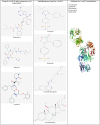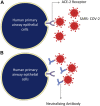SARS-CoV-2: Pathogenesis, Molecular Targets and Experimental Models
- PMID: 33967772
- PMCID: PMC8100521
- DOI: 10.3389/fphar.2021.638334
SARS-CoV-2: Pathogenesis, Molecular Targets and Experimental Models
Abstract
The severe acute respiratory syndrome coronavirus 2 (SARS-CoV-2) is a recent pandemic outbreak threatening human beings worldwide. This novel coronavirus disease-19 (COVID-19) infection causes severe morbidity and mortality and rapidly spreading across the countries. Therefore, there is an urgent need for basic fundamental research to understand the pathogenesis and druggable molecular targets of SARS-CoV-2. Recent sequencing data of the viral genome and X-ray crystallographic data of the viral proteins illustrate potential molecular targets that need to be investigated for structure-based drug design. Further, the SARS-CoV-2 viral pathogen isolated from clinical samples needs to be cultivated and titrated. All of these scenarios demand suitable laboratory experimental models. The experimental models should mimic the viral life cycle as it happens in the human lung epithelial cells. Recently, researchers employing primary human lung epithelial cells, intestinal epithelial cells, experimental cell lines like Vero cells, CaCo-2 cells, HEK-293, H1299, Calu-3 for understanding viral titer values. The human iPSC-derived lung organoids, small intestinal organoids, and blood vessel organoids increase interest among researchers to understand SARS-CoV-2 biology and treatment outcome. The SARS-CoV-2 enters the human lung epithelial cells using viral Spike (S1) protein and human angiotensin-converting enzyme 2 (ACE-2) receptor. The laboratory mouse show poor ACE-2 expression and thereby inefficient SARS-CoV-2 infection. Therefore, there was an urgent need to develop transgenic hACE-2 mouse models to understand antiviral agents' therapeutic outcomes. This review highlighted the viral pathogenesis, potential druggable molecular targets, and suitable experimental models for basic fundamental research.
Keywords: COVID-19; SARS-CoV-2; drug discovery; molecular targets; pathogenesis.
Copyright © 2021 Kanimozhi, Pradhapsingh, Singh Pawar, Khan, Alrokayan and Prasad.
Conflict of interest statement
The authors declare that the research was conducted in the absence of any commercial or financial relationships that could be construed as a potential conflict of interest.
Figures





Similar articles
-
Current status of antivirals and druggable targets of SARS CoV-2 and other human pathogenic coronaviruses.Drug Resist Updat. 2020 Dec;53:100721. doi: 10.1016/j.drup.2020.100721. Epub 2020 Aug 26. Drug Resist Updat. 2020. PMID: 33132205 Free PMC article. Review.
-
The TMPRSS2 Inhibitor Nafamostat Reduces SARS-CoV-2 Pulmonary Infection in Mouse Models of COVID-19.mBio. 2021 Aug 31;12(4):e0097021. doi: 10.1128/mBio.00970-21. Epub 2021 Aug 3. mBio. 2021. PMID: 34340553 Free PMC article.
-
SARS-CoV-2 Isolates Show Impaired Replication in Human Immune Cells but Differential Ability to Replicate and Induce Innate Immunity in Lung Epithelial Cells.Microbiol Spectr. 2021 Sep 3;9(1):e0077421. doi: 10.1128/Spectrum.00774-21. Epub 2021 Aug 11. Microbiol Spectr. 2021. PMID: 34378952 Free PMC article.
-
The K18-Human ACE2 Transgenic Mouse Model Recapitulates Non-severe and Severe COVID-19 in Response to an Infectious Dose of the SARS-CoV-2 Virus.J Virol. 2022 Jan 12;96(1):e0096421. doi: 10.1128/JVI.00964-21. Epub 2021 Oct 20. J Virol. 2022. PMID: 34668775 Free PMC article.
-
Review of studies of severe acute respiratory syndrome related coronavirus-2 pathogenesis in human organoid models.Rev Med Virol. 2021 Nov;31(6):e2227. doi: 10.1002/rmv.2227. Epub 2021 Mar 25. Rev Med Virol. 2021. PMID: 33763936 Free PMC article. Review.
Cited by
-
Experimental Models of COVID-19.Front Cell Infect Microbiol. 2022 Jan 5;11:792584. doi: 10.3389/fcimb.2021.792584. eCollection 2021. Front Cell Infect Microbiol. 2022. PMID: 35096645 Free PMC article. Review.
-
Evaluation of Novel Guanidino-Containing Isonipecotamide Inhibitors of Blood Coagulation Factors against SARS-CoV-2 Virus Infection.Viruses. 2022 Aug 5;14(8):1730. doi: 10.3390/v14081730. Viruses. 2022. PMID: 36016352 Free PMC article.
-
Plasma gp96 is a Novel Predictive Biomarker for Severe COVID-19.Microbiol Spectr. 2021 Dec 22;9(3):e0059721. doi: 10.1128/Spectrum.00597-21. Epub 2021 Nov 24. Microbiol Spectr. 2021. PMID: 34817280 Free PMC article.
-
Development and optimization of a high-throughput screening assay for in vitro anti-SARS-CoV-2 activity: Evaluation of 5676 Phase 1 Passed Structures.J Med Virol. 2022 Jul;94(7):3101-3111. doi: 10.1002/jmv.27683. Epub 2022 Mar 23. J Med Virol. 2022. PMID: 35229317 Free PMC article.
-
Induced pluripotent stem cells: Generation methods and a new perspective in COVID-19 research.Front Cell Dev Biol. 2023 Jan 17;10:1050856. doi: 10.3389/fcell.2022.1050856. eCollection 2022. Front Cell Dev Biol. 2023. PMID: 36733338 Free PMC article. Review.
References
-
- Abo K. M., Ma L., Matte T., Huang J., Alysandratos K. D., Werder R. B., et al. (2020). Human iPSC-derived alveolar and airway epithelial cells can be cultured at air-liquid interface and express SARS-CoV-2 host factors. bioRxiv. 10.1101/2020.06.03.132639 - DOI
Publication types
LinkOut - more resources
Full Text Sources
Other Literature Sources
Miscellaneous

